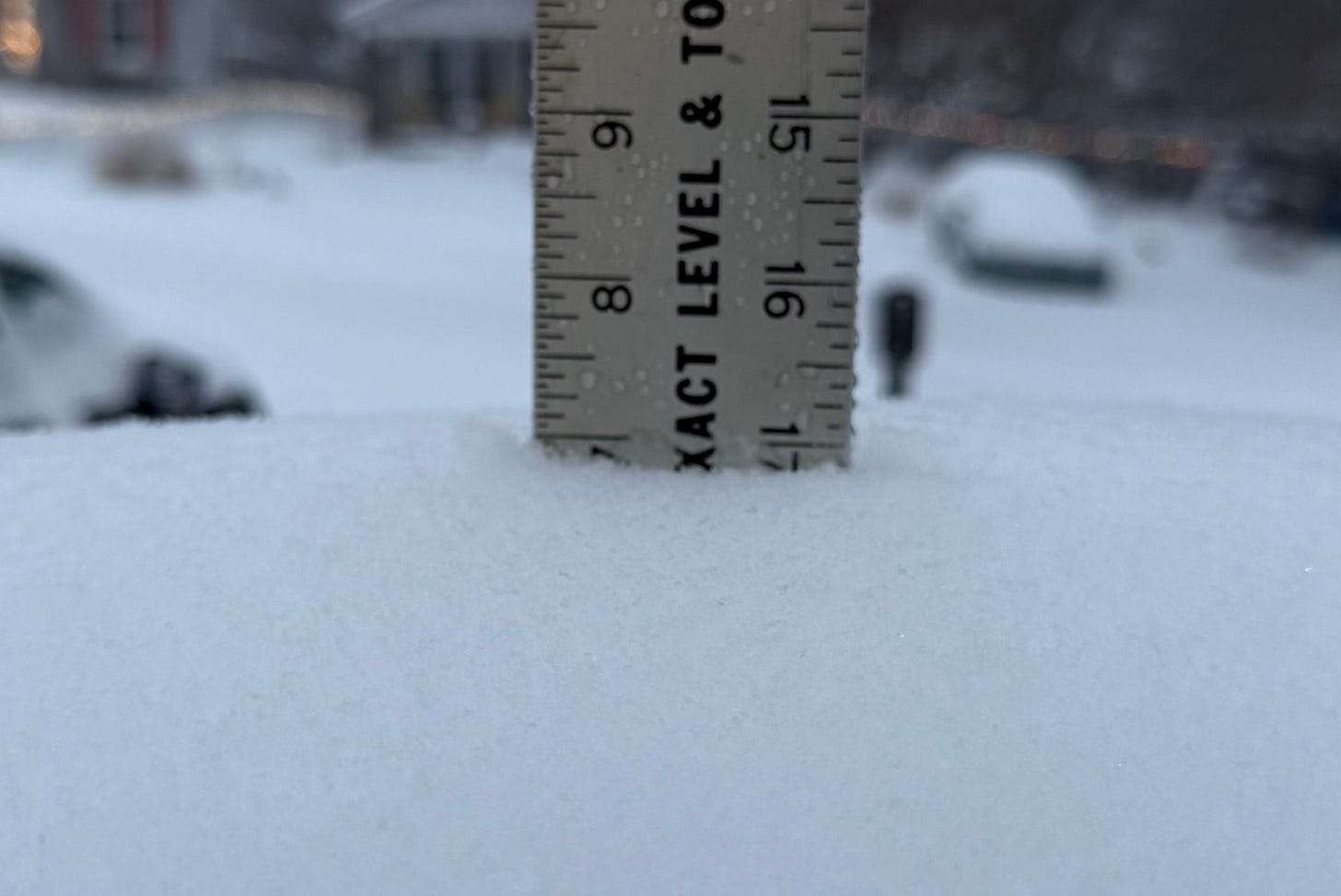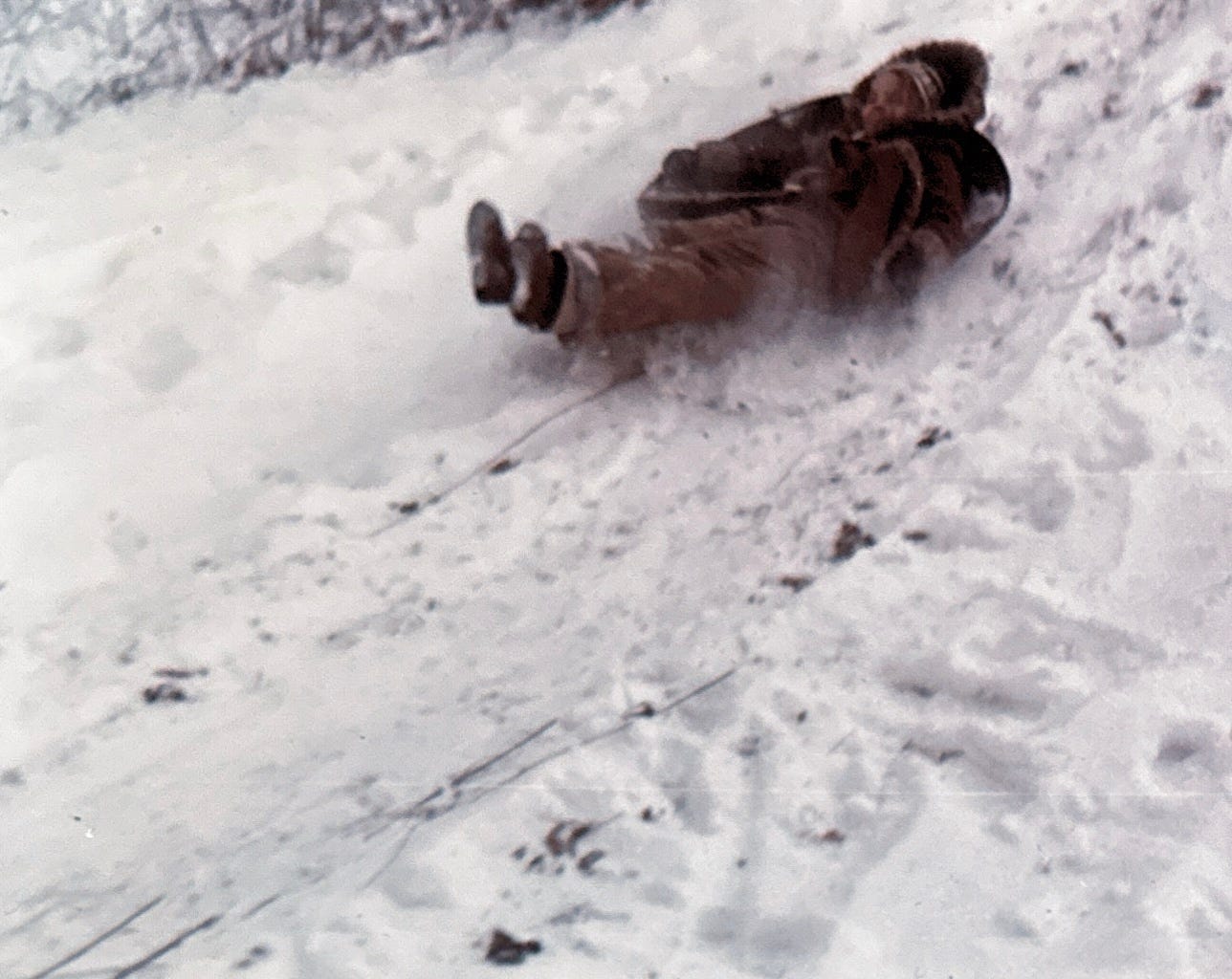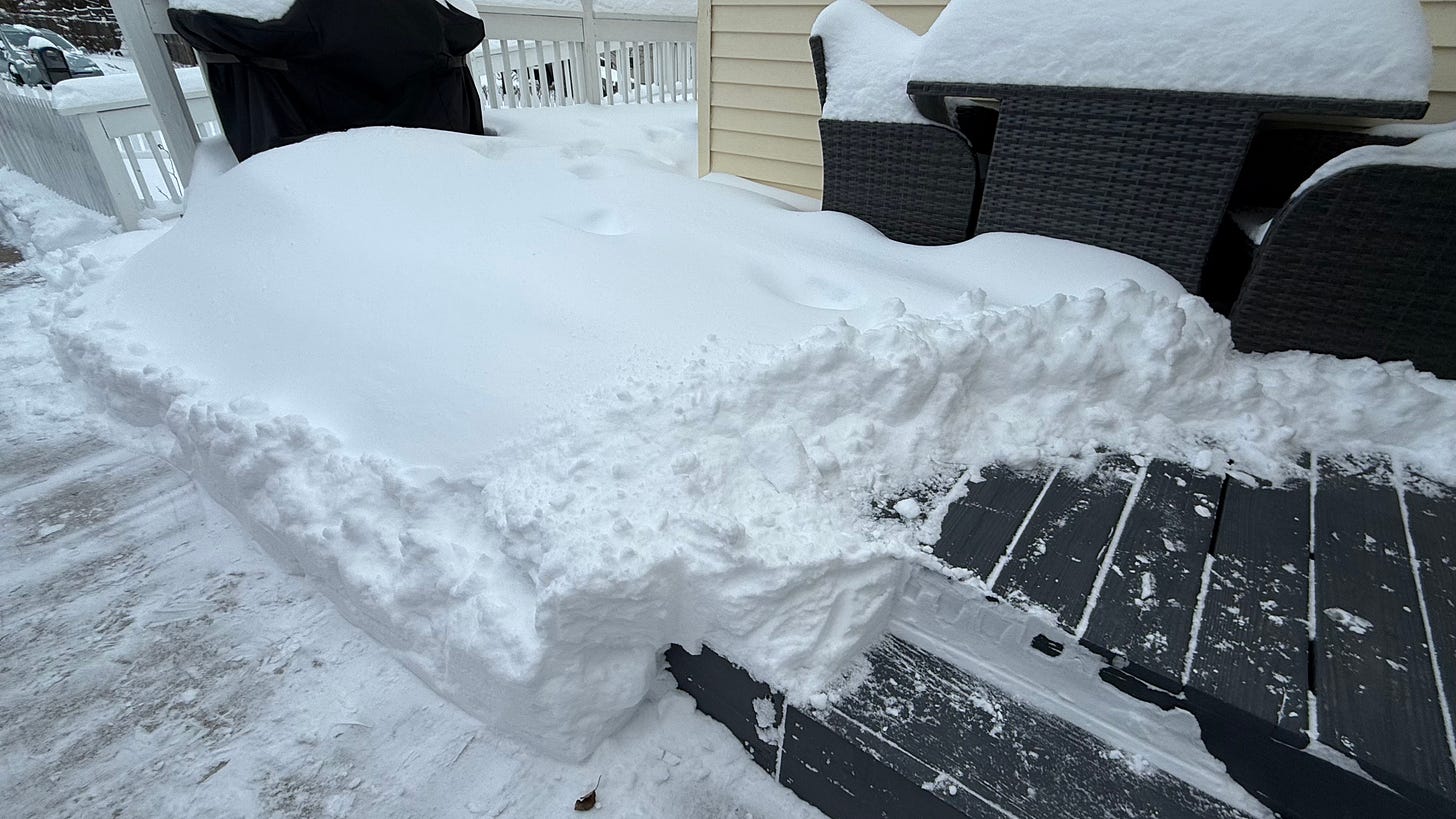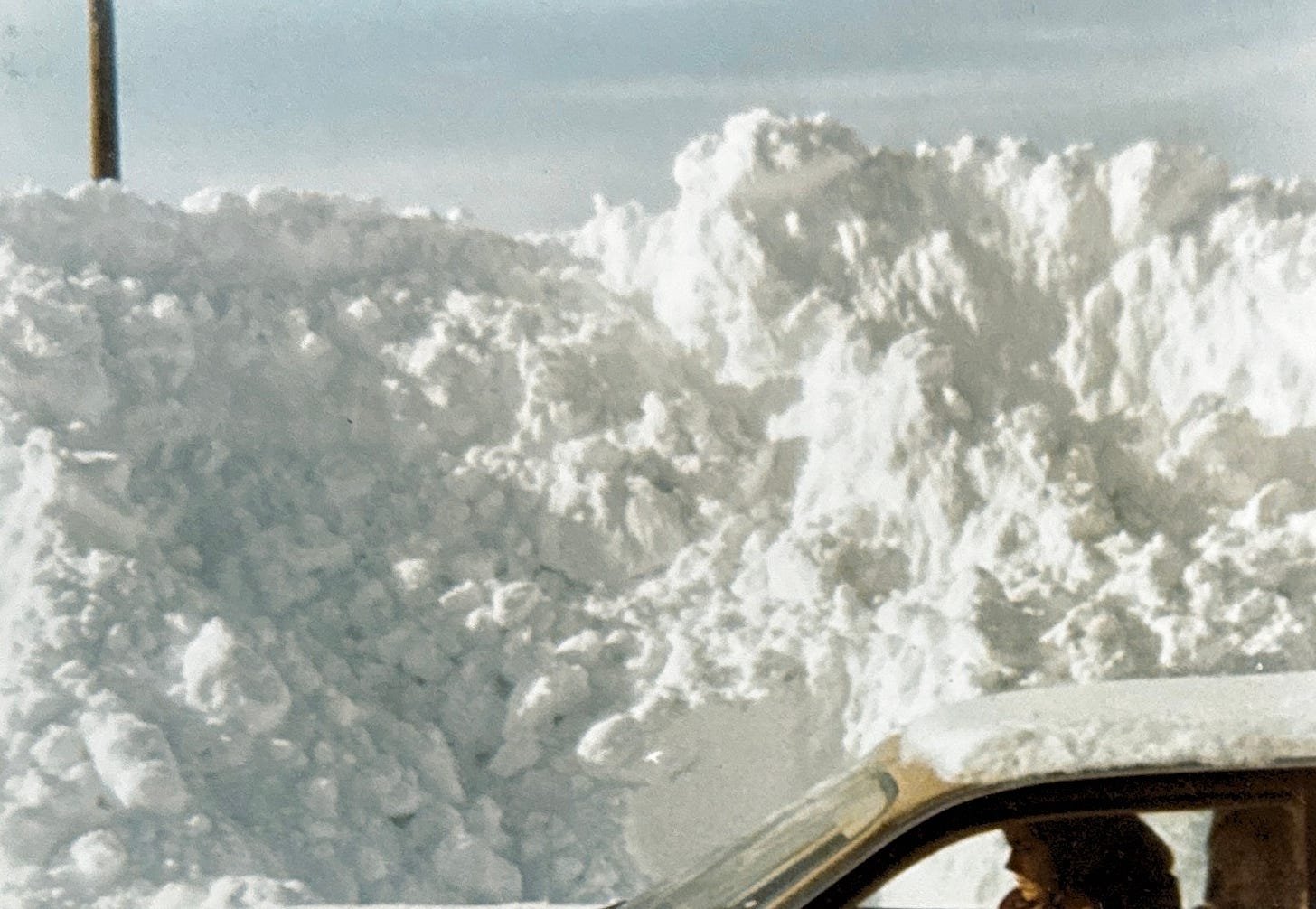Shovels, not sleds, on adult snow days
With all the complaints about cold and snow, here’s a moment of gratitude and a look back at the Blizzard of 1978

Sitting at the kitchen table, I watch the first inch of 11 inches of snow float to the ground. The natural beauty mesmerizes my husband, who can barely stop staring out the window, watching the flakes accumulate. His excitement is contagious.
Hundreds—maybe thousands—of football fans have seen my husband intently sliding up and down the sidelines with a camera to his eye. What few knew, though, was that the first game of the local high school season kicked off his battle with Seasonal Affective Disorder (SAD—talk about an on-the-nose acronym). Once the depressive thoughts started, they would infiltrate his energy and wake up dark thoughts that stole his motivation and pummeled his self-worth. On December 21—the shortest day of the year—he could finally take tiny breaths because he had made it to the bottom and could start his ascent out of hell.
The snow has only been falling a few hours, and the city street department arrives to spread salt on our cul-de-sac. Living in the city with reliable electricity, an all-wheel-drive vehicle, no place to go, and the ability to work at home helps.
In 36 years, we have suffered and survived harsh winters—losing power, cars sliding off the road, being stranded in the cold, hustling to negotiate more propane fuel to heat the house, and struggling to recover from holiday expenses. During those times, we easily forgot our wonder and happiness at the first flakes—hearing school cancellations, building snowmen, wheelbarrow sledding, making perfect snow angel, and eating snow cream.
The second city truck—a plow this time—scrapes and clears snow from the cul-de-sac while flakes fall in heavy waves making his efforts barely noticeable.
I was 9 years old during the Blizzard of 1978. We moved to Kentucky from Indiana weeks before, and the mountains shielded us from the storms. Back home, the flat land allowed record-breaking wind gusts to shove the snow into drifts measuring in feet. As plows cleared the roads, the piles of snow grew monstrous. Our only exposure to the snow, ice, and subzero temperatures was through letters and calls from family. That would change.
My husband pulls on his coat, hat, and gloves and heads outside to remove several more inches from the driveway, sweep the porch, and uncover his car.
The four months before the blizzard were rough on my mom—her brother’s “friend” shot and killed him at a party. And then she packed up and followed my dad hundreds of miles away from her family to live in an unfinished concrete block house deep in the mountains with no running water to drink or bathe, only a wood-burning stove for heat and cooking, a two-hole outhouse—well, you know what that was for—and no phone. If my mom’s family—or anyone else—needed us, they had to call my great-grandparents a mile or so up the road, and Grandpa would walk down to let us know.
I hear voices and peek out the window to see my husband talking with the neighbors who have joining him outside to clear their own drives. They shout greetings and small talk while scraping, lifting, and tossing the snow.
With an excruciating headache, my mom fell into a deep sleep with dreams of standing next to a hospital bed where her sister was on life support. Hours later, as my dad struggled to wake her so she could return an urgent call home, she saw a vision of her brother and sister standing at the foot of her bed—and then she returned to us.
My husband and the neighbors take a break as the snow gets heavier. He shakes the snow off boots and then grabs a broom to sweep off the porch, before heading inside. “That should be it for a while.”
The next few days overshadowed the massive snow drifts lining the state highway as we neared Mom’s hometown. Just like her dream, she stood over her sister’s hospital bed until three brain scans revealed she was already gone.
When my husband stops his snow surveillance to help me move arts and crafts equipment and materials from my office to a renovated room we now call “The Art Room” (Music-Paint-Pottery-Cricut Room was too long), he returns to find he has lost the battle of the snow-cleared driveways. The neighbors have continued shoveling, while our neglected driveway has grown deeper and deeper.
Before moving to our present home, we lived in a remote neighboring county known for being Indiana's hilliest, most scenic region. Waking up to fresh snow clinging to tree branches and insulating us from the outside world was magical—a real winter wonderland—until we had to drive in it. I look back at the days when we couldn’t work remotely and didn’t have a reliable vehicle, and I realize the struggles eclipsed special little moments that we have lost forever. So, when my husband started addressing his SAD a few years ago with a combination of mindfulness, meditation, supplements, and hormone rebalancing, we started shifting our mindsets to focus on being present and grateful, which means fewer of those special snapshots are lost.
I think of Claire in the movie Elizabethtown. Kirsten Dunst portrays a flight attendant who meets a failed shoe designer (played by Orlando Bloom) returning home to prepare for his father’s funeral. When Claire sees a moment she wants to save, she raises her hands in the shape of a camera and snaps a “photo.”
Today, I hold my own invisible camera, capturing my husband as he watches the snow. “I know you won’t believe I’m saying this, but it’s so beautiful,” he says, looking at me and then back outside like a boy eager to plunge into the snowbank. “Who am I?”
Click.







Thank you for sharing that. I suspect that many people suffer from SAD who either don't recognize the symptoms and just push on, or deny it, or accept it but don't know what to do about it. I walk miles and miles when the weather permits and I so enjoy walking and hiking in these hills and I miss it very much when the weather makes it unsafe. Keep bringing us your therapy :-D